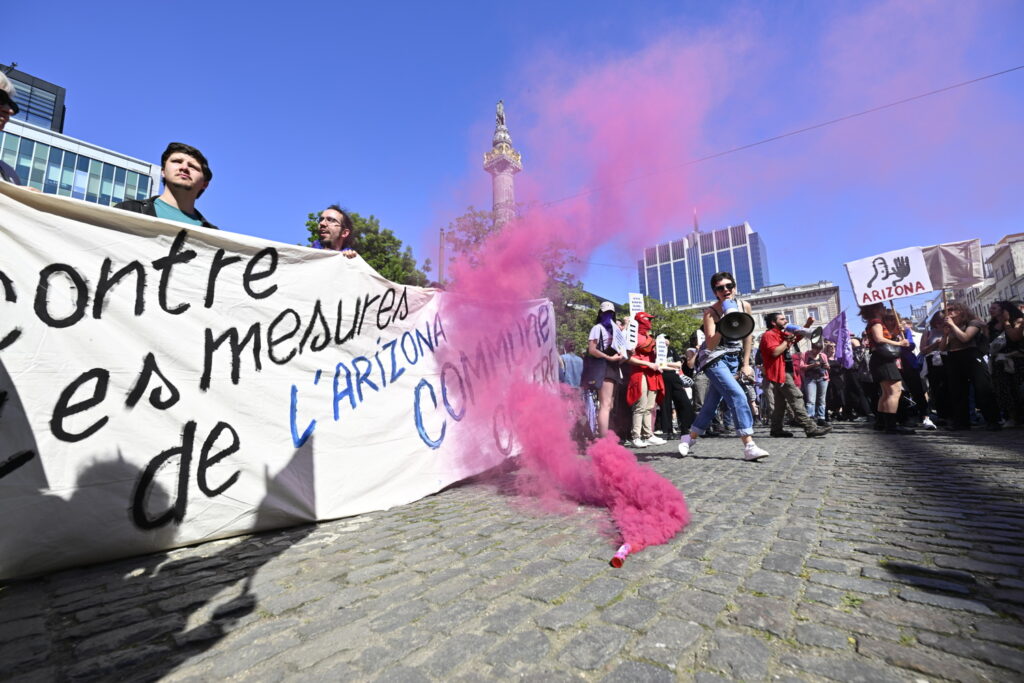Thousands of people took to the streets of several Belgian cities on Tuesday for a national day of action organised by the FGTB/ABVV and ACV/CSC trade union federations to show their dissatisfaction with the federal government's austerity and pension reforms.
Protesters oppose measures from the government’s Easter budget agreement for 2025, such as time-limited unemployment benefits, pension reforms, especially for public sector workers, cuts to public services, and more flexible working hours, including nights, Sundays, and holidays.
The unions argue that these measures are incompatible with increasing the Defence budget to 2% of GDP from this year.
Protestors call for a wealth tax
In Brussels, thousands of people - about 4,000, according to police and the Christian ACV/CSC federation, 7,000 according to socialist federation FGTB/ABVV - marched from Boulevard Albert II to Mont des Arts, where the demonstration ended at about 2:00 p.m. after several speeches.
During the march, union delegates left a coffin bearing the inscription 'Bury the antisocial Arizona project' outside the headquarters of the Nieuw-Vlaamse Alliantie (N-VA), the party of Prime Minister Bart De Wever, which was barricaded by police.
[Belgium's ruling coalition is known as 'Arizona' because the colours of the parties that comprise it all appear on the flag of that US state.]
The protest also stopped at the Finance Tower, where banners were unfurled demanding a wealth tax. The 'Commune colère' collective posted similarly themed placards.
Peaceful demonstrations
The demonstration in Brussels proceeded peacefully, as did other actions across the country.
In the Liège area, 5,000 people (according to police, 8,000 according to the unions) marched from the Cora store in Rocourt to the Citadelle Hospital, arriving just before 1:00 p.m. This symbolic route connected the private and public sectors. The protesters dispersed by 2:00 p.m., after speeches in the adjacent park.
In Charleroi, over 1,000 people marched from the Public Social Action Centre, CPAS, towards Ville Basse. Many striking workers participated, including employees of the CPAS and Walloon transport company TEC, joined by workers from La Louvière and Walloon Brabant, along with young FGTB and CSC activists.
Fewer protesters gathered in Namur, where 200 FGTB members mobilised from 5:30 a.m. They first picketed outside the central workshop of national railway company SNCB in Salzinnes, then assembled at Rue des Bas Prés at 8:30 a.m. before marching to Namur station, where several union leaders spoke.
'Constructive' meeting with Employment Minister
In Bièvre, union representatives met with Federal Minister of Employment and Economy David Clarinval to discuss the “antisocial” measures of the Arizona coalition. The minister described the meeting as “respectful” and “constructive,” hinting at potential areas of agreement despite differences.
“The mobilisation is effective, but there is still much to do,” Sébastien Carboni, regional secretary of FGTB Namur, remarked after the meeting.
Antwerp saw between 4,000 and 5,000 protesters according to local police. “We say no to this wrecking government,” an ACV spokesperson declared during the event, which ended at Sint-Jansplein at around 1:00 p.m.
Hasselt and Ghent hosted 2,500 and 1,800 demonstrators respectively. In Hasselt the demonstrators criticised the “social monstrosity” of the federal measures, while in Ghent, protesters handed out cacti, symbolising “thorny working conditions.” A similar action took place in Leuven, but only a few dozen demonstrators participated.
Substantial impact on land,sea and air transport
The day’s actions significantly disrupted services. Only six out of ten IC trains ran on Tuesday, while there was substantial impact on trams, metros, and buses from TEC, Stib, and De Lijn. Some Eurostar trains between Brussels and Paris were cancelled, accounting for about one-sixth of scheduled trips.
Airports were not spared: all flights were cancelled at Charleroi Airport. There were no departures from Brussels Airport, and only half the scheduled arrivals.
Maritime traffic was temporarily crippled, with Zandvliet’s traffic centre closed, blocking 50 ocean-going ships and over 200 inland boats at the Port of Antwerp.
Waste collection and postal deliveries were also disrupted.

